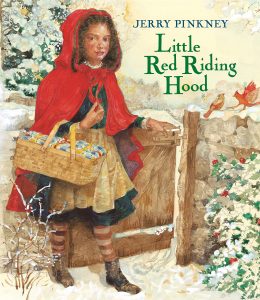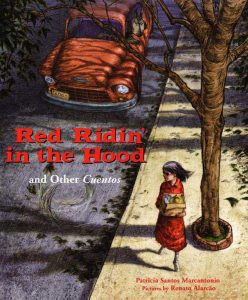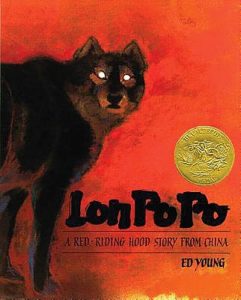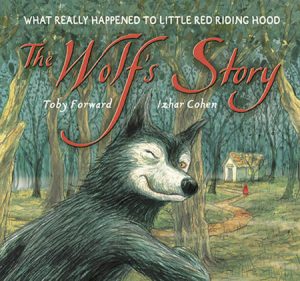A Story Exploration at North Valley Elementary School
Sylvia Najera
North Valley Elementary School is located in San Miguel, New Mexico, a rural area of southern New Mexico near the international border of the United States and Mexico. Students from the surrounding communities of La Mesa, San Miguel, Chamberino, and other small communities nearby make up the predominately Latinx (95%) enrollment of 268 students. North Valley is one of 27 schools in the Gadsden District. The school is special for many families in the community. Generations of family members have attended North Valley Elementary, and now their children and grandchildren are attending the school with a goal that their younger family members are academically challenged and encouraged to succeed to the best of their abilities.
I have been teaching at North Valley Elementary for 23 years now. I have had the privilege to teach monolingual English curriculum and in a dual language setting at most grade levels from first grade to sixth grade. The school has been a dual language school for more than 14 years. As an educator, it is rewarding to see many of the North Valley Elementary students earn top ten honors and become valedictorians in the high school. Many students continue their schooling to become local nurses, doctors, business owners, and other productive citizens representing North Valley as the beginning of their educational endeavors.
I encourage students to continue striving to excel in all subjects and to participate in sports and any other club or programs North Valley Elementary has to offer. I’ve been a part of many Out-of-School Time Programs focused on math, reading, and STEM. The programs are fun and convenient to teach because the curriculum and materials are provided for me. Students enjoy participating in the programs offered, and they are exposed to academic skills and strategies that boost their knowledge and interest for their future learning.
One aspect of my teaching involves working with 4th– 6th grade students in an Out-of-School Time Program called Story Explorations. Typically, 14 to 15 students participate in the 90-minute program twice each week. The program runs for 12 weeks in the fall and 16 weeks in the spring.
Story Explorations: An Out-of-School-Time Program
During the 2021/2022 school year, I led a program call Story Explorations. The participants ranged from 3rd to 6th grade. The theme for the fall 2021 semester was based on Red Riding Hood stories. Throughout the semester, students listened to and interacted with a variety of traditional and fractured fairy tales in a text set connected to the theme (See Gallery 1).
- Little Red Riding Hood by Jerry Pinkney, 2007, Little, Brown Books for Young Readers, 9780316013550.
- Red Ridin’ in the Hood and Other Cuentos by Patricia Santos Marcantonio and Renato Alcarãu (illustrator), 2005, Farrar, Straus and Giroux, 9780374362416.
- Lon Po Po: A Red Riding Hood Story from China by Ed Young, 1996, Puffin Books, 9780698113824.
- The Wolf’s Story written by Toby Forward and Izhar Cohen (illustrator), 2006, Candlewick, 9780763627850.
Gallery 1. Story Exploration Picturebooks
The feature story from the text set was the fractured fairytale Red Ridin’ in the Hood, one of several stories in a collection of fractured fairytales from Red Ridin’ in the Hood and Other Cuentos written by Patricia Santos Marcantonio with illustrations by Renato Alarcão (2005). In Red Ridin’ in the Hood, Roja encounters Lobo Chavez driving his low rider down Forest Street in the barrio. Lobo Chavez asks Roja if she would like a ride to her Abuela’s apartment, but Roja declines. Lobo Chavez decides to go to Abuela’s house before Roja gets there. He plans to eat Abuela and then eat Roja when she arrives. Before he can carry out his plan Lobo Chavez is arrested by the police for threatening to eat people. Abuela and Roja live happily ever after.
Activities from Red Ridin’ in the Hood (Marcantonio, 2005)
Several literacy activities in the Red Ridin’ in the Hood (Marcantonio, 2005) Story Exploration invited students to engage in drama. Students created their own tableaux and wrote a script and then performed a reader’s theater.
Another activity focused on grandparents. Like Roja, students were invited to visit their grandparents. Students could call, use Zoom or visit in person. During their visit students were instructed to interview their grandmothers. Students were eager to present the result of their interviews to the rest of the class during the next meeting. Ian, a fourth-grade student, was surprised to learn some facts about his grandmother. He shared, “Can you believe my grandma didn’t get her first cell phone until she was 30 and married?” Danielle, a fifth-grade student, was intrigued to know that her grandmother played games that the family still plays when they get together. Danielle told the group, “My grandma has kept the tradition of playing some of the games she played when she was small like Loteria and hopscotch, which I learned when I was like in first grade.”
In the story, Lobo Chavez is arrested for planning to eat people. Roja and Abuela become the owners of Lobo Chavez’s lowrider and the story ends with Roja and Abuela driving off to go play Loteria. Two activities connected to this scene in the story. In the first activity students became self-directed learners when they created a replica of the hydraulic system used in lowrider vehicles. They used popsicle sticks, a hydraulic kit (syringes, plastic tubing, and syringe adaptors), and water to make a structure that resembled the front end of a lowrider. Students used the syringes to push water through the plastic tubing that had been attached to the popsicle structure. This action caused the structure to move up and down like a lowrider. Click on the video clip below to see a lowrider in action.
The final activity of the Red Ridin’ in the Hood (Marcantonio, 2005) Story Exploration was for students to create their own Loteria game so they could play the same game as Roja and Abuela. Loteria is a game similar to Bingo except players use illustrated cards instead of numbers. Students were eager to design their Loteria cards using the characters and different images from the stories in the text set like Lobo Chavez’s lowrider and Abuela’s casa (See Figure 1). This activity culminated with students playing their newly created Loteria game during Story Explorations. Afterwards, several students wanted to take the game home to share with their family members. Austin, a fourth grader, asked if he could borrow the game and play it with his family during a family gathering. As he returned the Loteria, I noticed that someone had laminated the big board. Austin’s mother had sent me a note stating, “I hope you don’t mind, but I laminated the large Loteria board so it can last you longer. We enjoyed playing the game with Austin.” It seems that families enjoyed Story Explorations as much as the students!
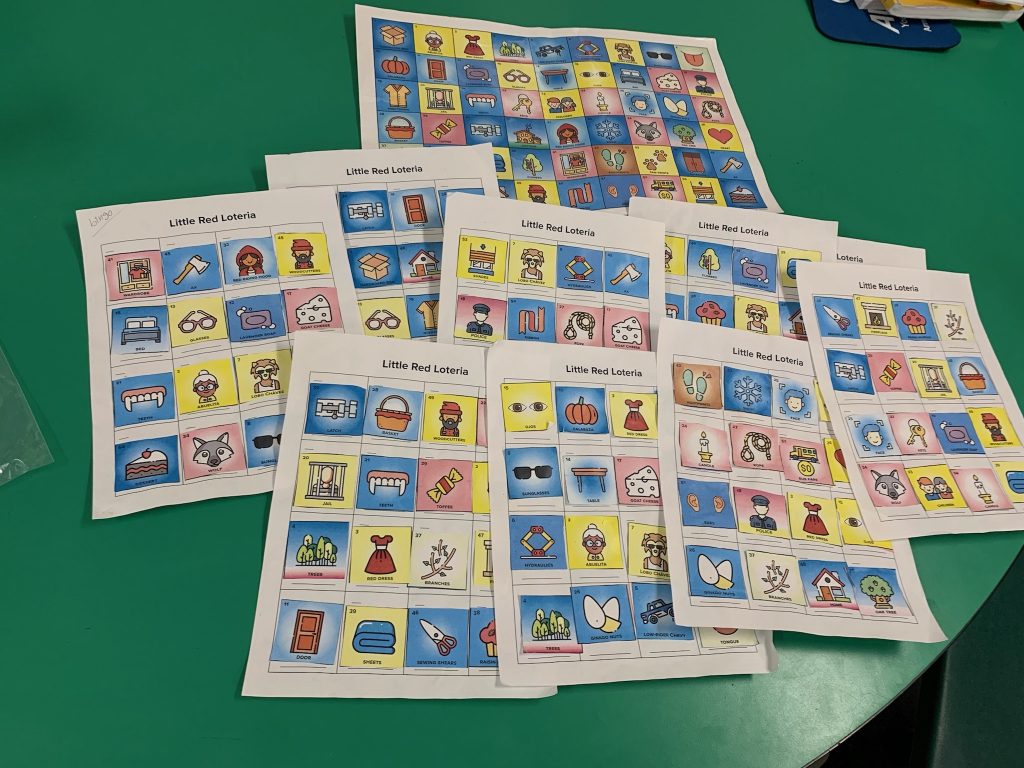
Figure 1. Students’ Loteria Game Cards
Throughout the Story Exploration in the fall semester, students used their background knowledge to connect to new characters, settings and plots portrayed in the different stories. Students enjoyed the different hands-on activities and expressed their interest in engineering and drama. As a result of the rigor and creativity embedded into all the activities, students were eager to share their experiences with other students in our school. Consequently, other classmates are eager to enroll in future Story Explorations.
As a result of implementing the Out-of-School Time Story Exploration Program I saw student engagement increase as students were eager and excited to interact with each new story in the text set. The rigor was evident in every lesson presented and undoubtably higher than the traditional read-and-answer-questions method that students are used to in the regular classroom setting. Students enthusiastically participated in all activities and were ready to assist their classmates if they were struggling or had questions. As a veteran educator I learned new and innovative ways to make sure students see themselves in an engaging and culturally relevant curriculum. I am looking forward to implementing Story Explorations again in the future.
Sylvia Najera is a Bilingual Dual Language Educator with 23 years of experience teaching from 1st to 6th grade students. She currently teaches at North Valley Elementary School located in San Miguel, New Mexico.
Children’s Literature Cited
Marcantonio, P. S. (2005). Red ridin’ in the hood (illus. by R. Alarcão). In P. S. Marcantonio, Red ridin’ in the hood and other cuentos, pp. 21-30. Farrar, Straus and Giroux.
Authors retain copyright over the vignettes published in this journal and grant the journal right of first publication with the work simultaneously licensed under the following Creative Commons License:

WOW Stories, Volume X, Issue 2 by Worlds of Words is licensed under a Creative Commons Attribution-NonCommercial-ShareAlike 4.0 International License.
Based on work by Sylvia Najera at https://wowlit.org/on-line-publications/stories/wow-stories-volume-x-issue-2/6.
WOW stories: connections from the classroom
ISSN 2577-0551

